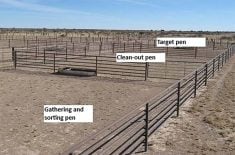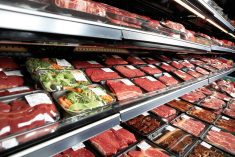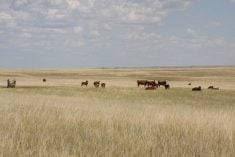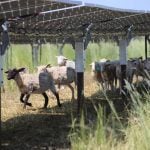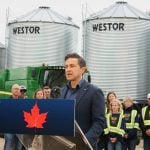Higher cattle prices make it more economically important than ever for producers to use the services of a veterinarian.
While prevention is the best policy with scours, treatment is possible with today’s good electrolyte solutions. Hooking a calf up to intravenous fluids can save it in severe cases.
These calves may be 100 pounds lighter than their contemporaries at weaning, but producers still have a calf and the cow maintains its productivity and will stay in the herd.
Treating broken legs can also have a good outcome as long as the break is not compounded, which means the bone is sticking through the skin.
Read Also

Teamwork and well-designed handling systems part of safely working cattle
When moving cattle, the safety of handlers, their team and their animals all boils down to three things: the cattle, the handling system and the behaviour of the team.
A veterinarian will use either fibre-glass material or a splint, depending on the location. Using the right materials and removing the cast at the right time can result in a good prognosis.
It is important that animals be examined before treatment. They can be shipped if an ailment cannot be treated or the prognosis is low.
Remember to wait the designated time before shipping if antibiotics or other drugs with withdrawal times have been used.
A good working relationship with the local butcher or abattoir is recommended. Emergency slaughter can often salvage a large amount of the meat’s value in cases of a broken leg or a downer animal from injury.
The reason the animal is down must be determined because there can be different outcomes depending on whether the cause is from injury, a dead fetus inside or a bad mastitis.
Many producers have skimped on management procedures since BSE rocked the industry in 2003. That was understandable when prices were bad, but the market has improved and with it enthusiasm among producers who survived the bad times.
Some producers stopped pregnancy checking, vaccinating or evaluating their bulls’ semen.
Take time to re-examine these management strategies and remember that you want to pass a quality product to the next link in the beef production chain.
Pregnancy checking helps identify open cows that should be culled, which reduces feed and labour costs.
The open cows can be marketed at the same time or grouped with neighbours’ open cows for load lot marketing.
Semen checking bulls has similar benefits. Producers may even be able to increase their cow-to-bull ratio, knowing that their bulls are all fertile.
Use the vaccination program that your veterinarian recommends because he knows your region and the type of operation you run.
Producers should have their heifer replacements palpated before breeding to identify and cull free-martins, small pelvised animals and those that are reproductively immature. As well, give shots for IBR and BVD to prevent infectious reproductive diseases, which could improve conception rates.
Implanting strategies and treating parasites are definitely worth doing to increase the bottom line.
A producer’s implant strategy should best use his type of feed and the length of time he owns the calves. Marketing methods, either on the rail or by the pound, may also influence the type of implant used.
Many types of implants are available with varying lengths of duration and strength. Work with a veterinarian to devise the best implant strategy.
Post mortems are also an expense, but veterinarians can learn much from a timely examination and save producers money.
This is especially true if they identify a preventable disease or one such as coccidiosis where preventive treatment strategies can be devised.
Take the animal in for an autopsy if an unexplained death occurs. Looking at the internal organs can usually identify the cause of the problems and evaluate the response to treatment.
Other procedures, such as foot care, udder care, monitoring the eyes closely for early signs of cancer eye, examining lumps and bumps and treating wooden tongue or lumpy jaw, can also increase an animal’s life span and improve market value.
In today’s improved market, invasive procedures such as cancerous eye removal and claw amputations for septic arthritis can restore value and eliminate a potential animal welfare scenario. These cows can often stay in the herd for several more years.
Think of all these things next time you are hesitant to call your veterinarian.


